A Feel for Forensics
Text by Gregory Thomas

Searching for human remains, weapons and other crime scene evidence in zero visibility is a duty ‘deeply felt’ by the volunteer Alameda County Dive Team
A middle-aged woman paused at the end of the pool, between laps, and studied the man in the next lane. He was fiddling with his goggles, having just swum the length of the 100-foot (30m) long pool, along the bottom, in one breath.
She’d been wondering about him for weeks. His swimming habits were unique. For example, she had never seen him swim on the water’s surface. More unusual was what he did when he reached the deep end. He’d sink to the bottom, shut his eyes, cross his arms over his chest, and recline there, motionless, for minutes at a time.
Sometimes he’d bring items down there with him: a dive mask; an underwater writing slate; a dive computer. She’d seen him on the bottom lifting lead weights. He was tall and muscled, with a thick chest. The woman thought perhaps he was a football player in training so she asked him.
“That’s funny,” he said, smiling. “I don’t play football. I’m slowly programming my body’s responses—so I won’t panic when I’m in the water, doing what I need to do.”
The man, 42-year old Steven Day, was practicing for a time when he might need to haul a dead body off the bottom of Lake Merritt. It wasn’t out of the question, given his line of duty as a new recruit of the Alameda County Dive Team, a volunteer group that carries out underwater forensic work for the Sheriff’s Office. When a car winds up at the bottom of the Oakland Estuary, when someone throws a gun off the Berkeley dock, or when a person is missing for too long, the dive team is called out to scour and scrape the depths in places no one sees. It’s not rescue work; it’s recovery. This is the team that led the search effort for the body of murder victim Laci Peterson in San Francisco Bay in 2004. Established in 1952, it’s the oldest team of its kind in the state—perhaps the oldest in the country—and it’s voluntary. None of the members are paid for their trouble. In fact, members lose money on assignments that take time away from their jobs.
The work is physically demanding and mentally jarring
With one arm draped over the edge of the pool, Day explained some of that to the woman who’d been watching him. His exercises at the pool kept him sharp, he said. Then he bid her good morning, hoisted himself out of the water and walked through the cool air to the locker room. The woman stayed and thought a moment, absorbing the new information. “I respect the work that he does,” she told me. “I wouldn’t want to be in the water he’s in, looking for what I imagine he’s looking for.”

Blackwater Grad
It takes a certain kind of person to volunteer in the search for human remains in mucky lakes and waterways. It’s cold and dark under the water, which makes actually looking almost impossible. So the diver goes by feel alone, arms outstretched in front of him, fanning along his sides—making snow angels in the mud, the team members like to say. Even if he doesn’t manage to poke his fingers against a person’s decaying body he’s liable to plow headfirst into, say, a roll of discarded barbwire or a stray oil drum—or something else.
“Whatever someone wants to get rid of and doesn’t want found—that’s what we’re for,” said Day, weaving through freeway traffic in his Jeep Wrangler one evening last fall. Day was running late to his team’s monthly meeting at a police compound in the hills above Dublin. He parked his jeep and walked into an auditorium to check in with Rebecca Gandsey, the team’s liaison in the Sheriff’s Office. She handed him a plastic I.D. card and smiled.
“It’s Christmas for Steven,” Gandsey said, handing Day the I.D. “He’s been waiting for this a long time.” Almost a year before he was accepted into ‘Blackwater Academy’ to undergo the team’s intensive five-month training. In March of 2011, after surfacing from a practice dive off the Berkeley dock, his training officer announced his unofficial acceptance as a team member. Receiving his I.D. card formalized his achievement and membership
on the team.
Most of the team was assembled for the meeting—about 40 men in all, mostly middle-aged, some thicker in the waist than others. They all wore the same shirt that on the back read, “Alameda County Sheriff’s Office” around a single word in white capital letters: DIVER.
At the front of the room, Chief Dave McMurdie read through the litany of official business items on the night’s agenda, then he paused. The second bullet point under the fifth item read 9/27 Training dive,1830 hours, Shadow Cliffs.
“I want that MAC-10 back!” McMurdie announced. He was talking about a mock sub-machine gun the team tossed into the Pleasanton lake a couple months before and hadn’t retrieved. Searching for fake weapons is a team exercise—practice for times when they’re called to look for the real thing. “It’s been rusting on the bottom of Shadow Cliffs for a while now,” McMurdie said. “I’d like it back.”

Dope on a Rope
There are 44 members on the dive team—43 of them are men—whose ages range from thirties to sixties. Each has personal reasons for joining. The work is time-consuming, physically demanding and mentally jarring. Ask them why they do it and you’ll hear about civic duty and personal responsibility—responses characteristic of military servicemen more than thrill-seekers. Pry a bit more, and the reasoning becomes less clear. After all, planting trees or volunteering as a crossing guard would be a much less risky way to give back to the community.
It’s dangerous work. All kinds of things can go wrong when you’re looking for nasty stuff in an alien world without the luxury of sight or sound.
I became totally comfortable with being uncomfortable
“It’s not rocket science in terms of the physical maneuvers. But mentally, that’s where it’s difficult,” said Tom West, the oldest member of the dive team. “Panic is a huge issue.”
Last November, on a body call in Alameda, one of the team members accidentally crawled into an open culvert. He had to back out—slowly. Divers have been sliced through their suits by razor wire and fishhooks, and ensnared in fishing line. “It’s like a Chinese finger prison,” West said of the webs of fishing line divers often encounter. “The more you struggle, the tighter it gets.” The former team member recalled an occasion pushing along the bottom and suddenly realizing that he couldn’t exhale. His face had been so close to the bottom that he’d pushed his regulator into the muck, clogging the vents. “It’s searching by Braille,” McMurdie says. “We call it being the dope on a rope.”
Nearly every team member is useful in an emergency. Many are full-time dive instructors and commercial divers; some are hobbyist spear fishermen, abalone divers and underwater photographers. Day’s fellow recruits include a U.S. Coast Guard rescue swimmer and two emergency medical technicians. Apart from his perseverance and civic-mindedness, Day doesn’t fit the team’s member profile. He’s not from the Bay Area, as are most of the members, or even the West Coast; he’s from Tennessee. Unlike the stable career men and retired guys who volunteer for the team, Day bounces between jobs teaching school and counseling troubled youths. He’s the team’s only black member, which sets him apart in a room of white men in blue uniforms. And he wasn’t a skilled waterman before he joined.
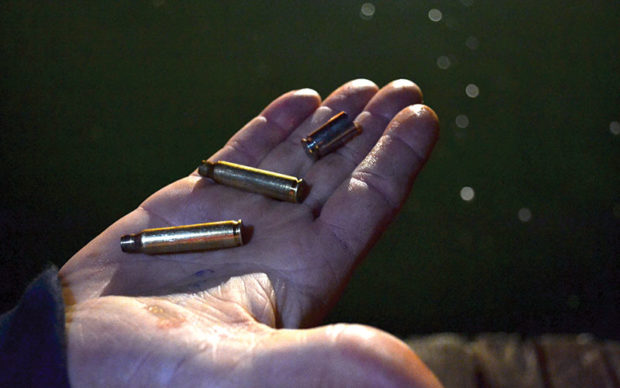
In fact, 11 years ago, Day didn’t know how to swim. Still true—he started learning in 2001.
“I remember when I first called to find out about the team, my heart felt like it was beating out of my chest,” Day said. “I ended up saying something silly like, ‘There’s not a lot of colour on that team and I’d like to try out.’”
It’s hard for Day to articulate his reasons for pursuing the team. He says he’s always been fascinated with crime and death, and that he’s naturally drawn to risky activities. He plays on a men’s rugby team and used to run dragonboat races. He’s looking forward to exploring motorcycle riding and archery. “Maybe I just read too many Navy SEAL books,” Day jokes. When you press him for an answer, he’ll relinquish details of a past riddled with setbacks that compelled him to channel his frustrations first into swimming and then into the team’s rigorous training program. It begins with a traumatic childhood experience.
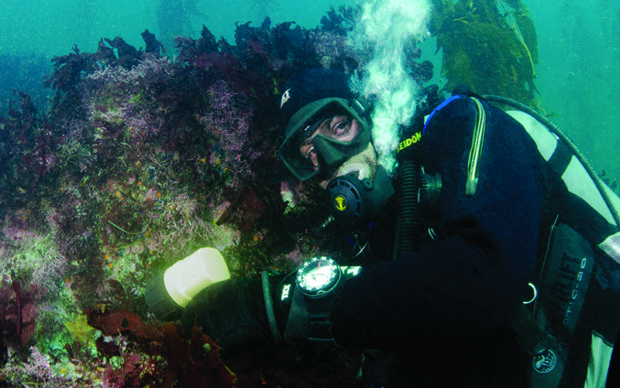
Military Mindset
Day grew up in land-locked Memphis, near the Mississippi River but far from lakes and the beach. “The closest water was a weed-choked, muddy area where catfish would spawn,” Day says. One hot summer day, in 1981, when he was between fifth and sixth grades, Day and a couple of his buddies were strolling around a community pool in their neighborhood, checking out older girls in bikinis. Then something happened that would keep Day away from the water for the next 20 years. He was walking near the deep end when, out of nowhere, his older brother blindsided him and heaved him into the water.
“The first thing I realized was that I’d been thrown. Next thing I know, I’m gasping and hacking and coughing underwater,” Day recalls. His buddies were tossed in too. None of them could swim. “We were like a daisy chain of newborns drowning,” he says. They struggled to the side of the pool and managed to pull themselves out. But now everyone, including the girls in bikinis, knew he couldn’t swim. “After that, I didn’t want anything to do with swimming pools.”
The day planner became a diary of his relationship with the water
Day arrived in the Bay Area in 1996 to take a teaching job, and soon enrolled in night school to get a law degree. That summer, between his first and second years in the program, was “tumultuous” as Day puts it. He broke up with his girlfriend of six years but had to stick out living with her for months until she found a new place. During the day, he ran papers as an extern at the U.S. Attorney’s Office in San Francisco. He bought expensive shoes and suits he couldn’t really afford for that job and more than once he fell asleep in them, on his couch, after long, stressful days.
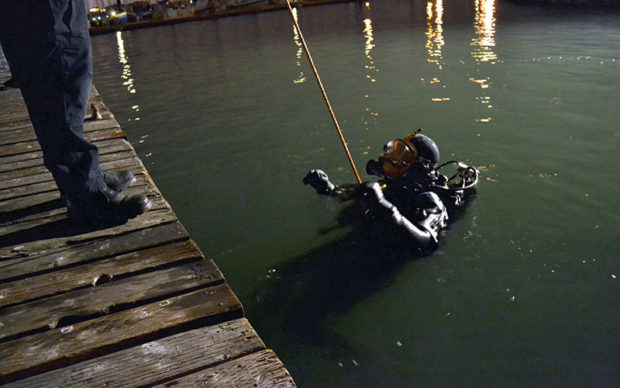
It was one of those nights, well after midnight, after he had passed out on his couch in work attire, when Day took his first steps in a new direction.
The apartment where he was living is located on a side street that dead-ends at a 12-acre green space marking the point where Oakland becomes hilly. Here’s his account of what happened that night in 2001. In an uncharacteristic bout of sleepwalking, Day had made his way from his apartment into a nearby park, unconsciously, coming to only when his knees collided with an iron gate surrounding a community pool. The first thing he noticed was a faint blue light undulating against the night fog above the pool.
“It was at that moment that it all came back and hit me at once,” Day said. “I was sick and tired of not being able to swim. The very next day I jumped into that very swimming pool. The goal was not to teach myself to swim but to prevent myself from drowning.”
He bought a day planner at a dollar store to track his progress. He learned not to drown by throwing himself into the deep end over and over again and dog-paddling his way to the edge. He taught himself to swim watching others swim laps, then mimicking their motions and working out the kinks as he progressed. He was visiting the pool six or seven days a week, multiple times a day. The day planner became a diary of his relationship with the water. Swimming was becoming a kind of escape. He started reading books written by Navy SEALs. Then he took some of that military mindset to the pool. He would tilt his head back underwater, deliberately inviting the water to climb deep into his nostrils until it felt like it was burning his brain.
“I used to flood that burning feeling out,” Day said. “I became totally comfortable with being uncomfortable” in the water.
He practiced holding his breath at work. Sometimes in the middle of the day, pool water would dislodge itself from inside Day’s head and pour out his nose. He suffered deep muscle pulls. But he felt clearer than ever. Swimming was helping him find himself. In a personal essay Day submitted as part of a job application for legal work, he wrote that the process of learning to swim as an adult has “provided the basic ingredients or fuel that I use when confronted with seemingly difficult or impassable situations” and “has had a continuous and profound impact in many areas of my life.”
His obsession soon grew too big for the pool. He sought scuba lessons.
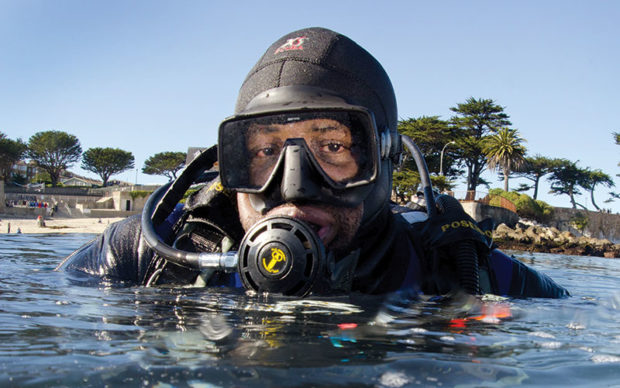
Infinite Learning Curve
The tenets of the forensic dive team—navigate blindly, search by feel and communicate via rope line—are well outside the purview of recreational and even commercial scuba diving. The cornerstone of traditional diving is a principle taught as “look only, touch nothing.” You go under to observe nature; you leave no trace. The team’s job is diametrically opposed to that approach. You search by feel.
Not everyone was made for it, says Jim Steele, Day’s dive instructor. “You have to be comfortable under the water when they turn the lights out.”
In 2008, after losing his job as a teacher, Day asked himself, “Steven, what would you do if you never needed another dime?” The answer: “I’d be an underwater archaeologist.” The rush of diving and the prospect of exploring an alien environment, in spite of the danger or perhaps because of it, made the dive team all the more appealing, Day says. “The learning curve will never flatten out.”
Here’s an example. One means of acclimating to the black water environment is the ‘cutting box’ exercise. You start by stretching duct tape over your dive mask, so you can’t see. There’s a milk crate on the bottom of a 10-foot (3m) deep pool, with lengths of various strings and cords tied and tangled to it. Your job is to find one loose end of each kind of cord, cut a length long enough to knot, then tie them in a daisy chain to your buoyancy compensator. You do this while wearing thick neoprene gloves. “We do it until it’s all just muscle memory,” McMurdie says. “We want to make sure it’s pure reflex.”
The exercise, in part, tests the ability of a diver to maintain focus for an extended period of time while deprived of his senses. After about 20 minutes crawling through black water, members say, concentration begins to blur and fade. One dive team member put it this way: “Everybody’s got an edge, and everyone’s edge is different.”
Day has now spent years training on the bottom of the swimming pool to hone his edge. He’s practicing to be the team’s priority diver on emergency assignments. “I want to be at the tip of the spear,” he says.

Crash Course
To an average scuba diver, the idea of groping around on the bottom of a waterway in Oakland is somewhat alarming. But I figured I’d try it myself, given what team members say about how nobody—not even experienced scuba divers—has a clue about what their job is really like.
I met John Lathsbury, a member of Day’s dive team, at the Alameda Marina one morning last November for a crash course in forensic diving. Standing on a small dock just off the marina parking lot, we considered the water we were about to jump into: a gray-green mixture separating Oakland from Alameda.
“They say there’s no bottom in the Alameda Estuary—the water just gets thicker,” Lathsbury said.
Lathsbury and I reviewed line signals in the marina parking lot. One tug: Are you okay? One tug back: I’m okay. Three tugs: Search right. Four tugs: Search left. 3-3-3: Surface, now! Six tugs: I’m in trouble!
We jumped into the water. A diver friend of Lathsbury’s knelt on the dock and clipped the rope to my vest before Lathsbury and I descended. As we sank, green water closed out the luminescent gray sky above, enveloping us in a swampy haze. It wasn’t black water, but my visibility was limited to what was directly in front of my mask. I lay on my stomach on the bottom, about 12 feet down, and attempted a circle pattern search—hunting for anything I could find. The idea is to explore the bottom, one centimeter at a time, with your fingertips.
Brushing a hand into the mucky sediment produced a small explosion of gray that didn’t settle back down. It was like swimming in a paint can. My limbs moved as swiftly as they would in a swimming pool, but the fog of sediment made the water seem thick and impenetrable. My senses struggled to perceive depth, leaving my mind oscillating between sensations of claustrophobia and infinity. Some of the divers say it’s easier to just close your eyes, so I did.
Slowly, my brain redirected my senses to my hands, and my arms fanned out in front of me. My fingers wrapped around something solid, and dislodged it. Was it a rock, a shell or some human artifact? I pulled it close to my mask to see it. Then closer. Then it was touching the lens of my mask but still somehow shrouded. It’s a bit unnerving to have working eyes that can’t see what’s in front of them. I set it back down and crawled forward.
After about 15 minutes, I felt a set of 3-3-3 tugs on my vest: Time to surface. I came up disoriented, intending to face the dock but with my back to it instead. McMurdie’s words were bouncing around in my head: “After about 15 minutes, you start to lose it.”
“Ask him what the bottom terrain is like,” Dan McCormick orders Justin, the communications man wearing a radio headset. “Is it weedy?”
Justin radios the inquiry to the diver in the water, Dan Longnecker, then relays his response. “He says, ‘Thick vegetation,’” Justin says. Day jots it down on a clipboard. He is profiling divers in the water during tonight’s exercise.
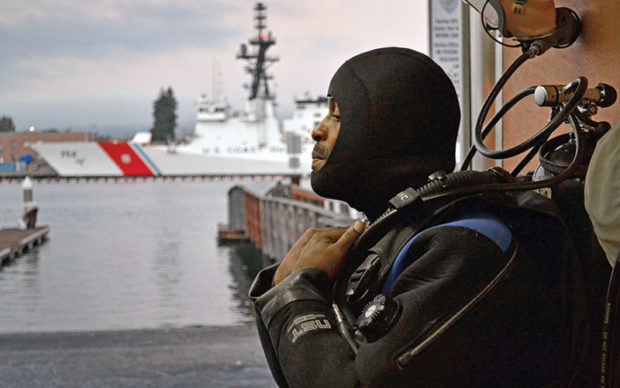
A moment later, Longnecker’s line tender felt three quick successions of four tugs—one of the team’s emergency signals. The end of the rope he’s holding stretches about 60 feet (18m) off the dock he’s standing on and disappears below the surface of a dark lake in Pleasanton, where the team is training. Tonight, divers are looking for the mock sub-machine gun McMurdie chastised the team about at the meeting earlier that month. The muddy lakebed is a hazardous course of long grass and other obstructions, like stray oil drums, that can distract a diver searching along the bottom.
The line tender announces the emergency to the men on the dock, who immediately stop what they’re doing and regroup. Day’s estimation puts the diver’s depth at about 12 feet (3.5m) and his breathing frequency at eight breaths per minute, judging by the intervals of bubbles that emerge on the water’s surface. Justin radios to Longnecker, the man in the water, who McMurdie calls ‘The Magnet’ for his prowess locating guns. Longnecker says he’s caught in the long grass and can’t untangle his fins. He’s been in the water longer than usual, more than 20 minutes, and his air might be running low.
Scotty, who just climbed out of the water from a dive, grabs his mask and hops back in to go after Longnecker. He kicks out on the surface about halfway then submerges. All eyes are on the water. Justin radios to Scott and Longnecker for a report, but no one is answering—just short bursts of static. A minute passes. Then another. Then a spot of lake in the area beyond the rope begins to bubble. Two heads pop up and begin a slow drift toward the dock. Hands reach out of the water as the divers’ pull their masks off their faces and regs from their mouths. The silence all around us is broken by their laughter.
Day helps haul the divers out of the water and everyone trudges back to the parking lot, where a floodlight presides over an open trailer. The divers drop their gear on a plastic tarp and peel themselves out of their wetsuits. While they’re dressing, Chad Noble, the acting superior officer, recounts the night’s exercise. It turns out Longnecker faked his entanglement.
“It was a test,” Chad announces. The team seems relieved at the news.
Wending out of the park in his Jeep, Day contemplates the impact of a year of feeling around underwater for guns and dead bodies. It has changed his perception of the Bay Area’s waterways. “I think about how the contour of the bottom is shaped now,” he says. “I think, ‘What’s under there?’” His stream of consciousness meanders into thoughts about diving in the dark.
“The way it works when you’re down there is your eyes try to fixate on something to get a point of reference, but that’s actually counterproductive,” he says. “You have to consciously abandon all your natural tendencies and everything they teach you in scuba.”
“It’s like taking a break. I have a bunch of fears but getting under the water, like, allows me to take that one big breath I’ve been waiting for,” he says. “I think I feel the most solace in the dark.”
Leave a Comment







